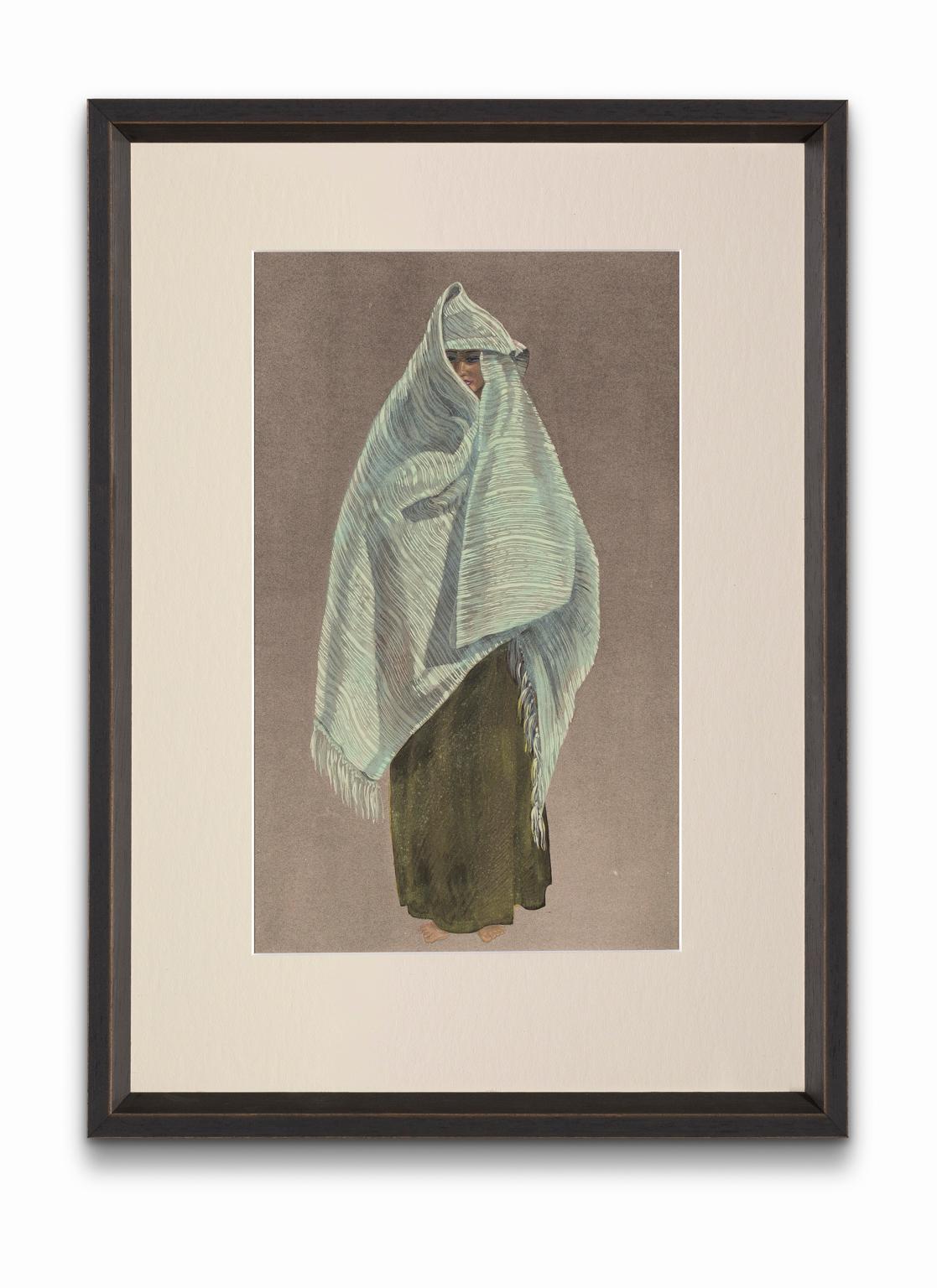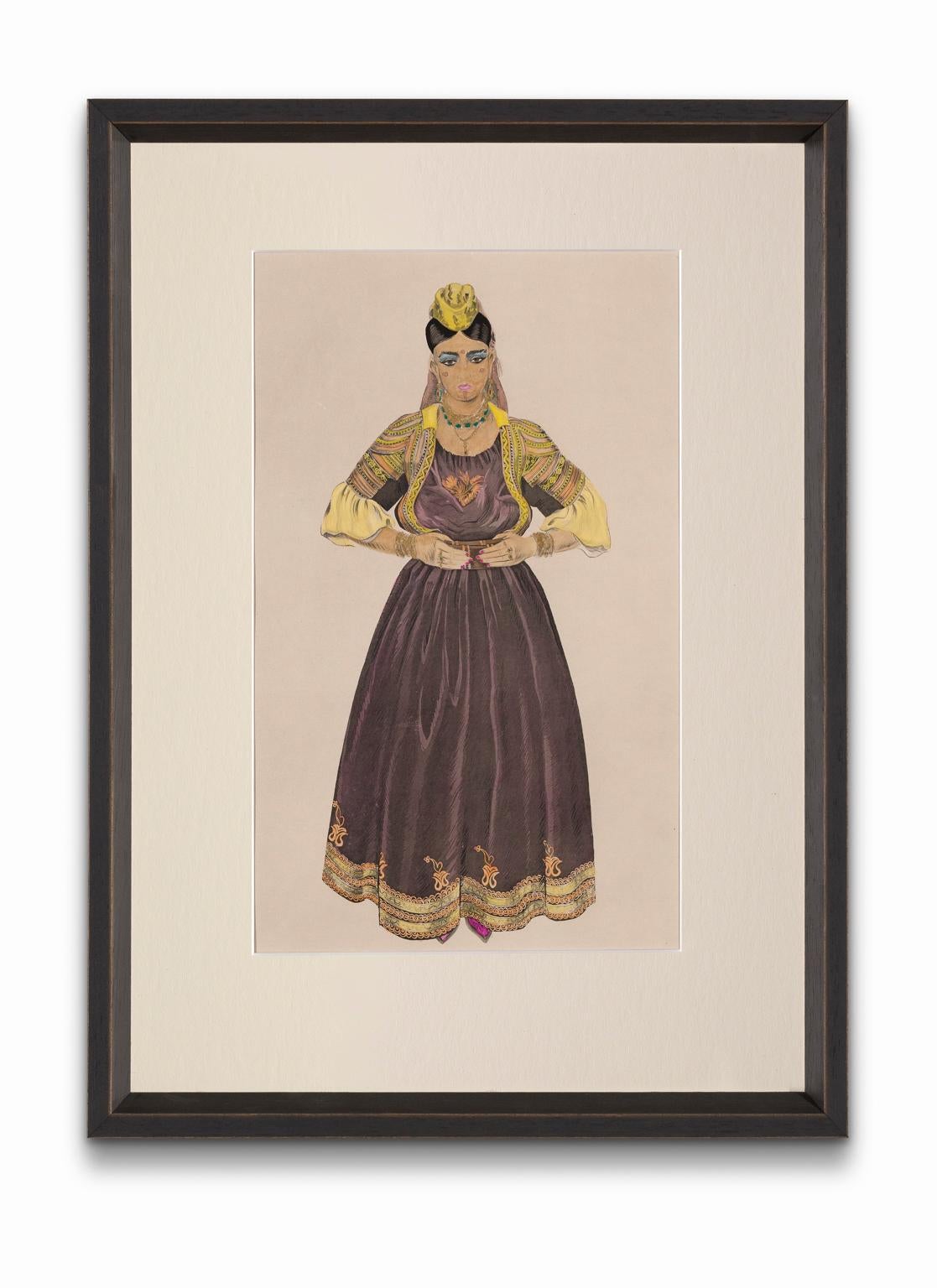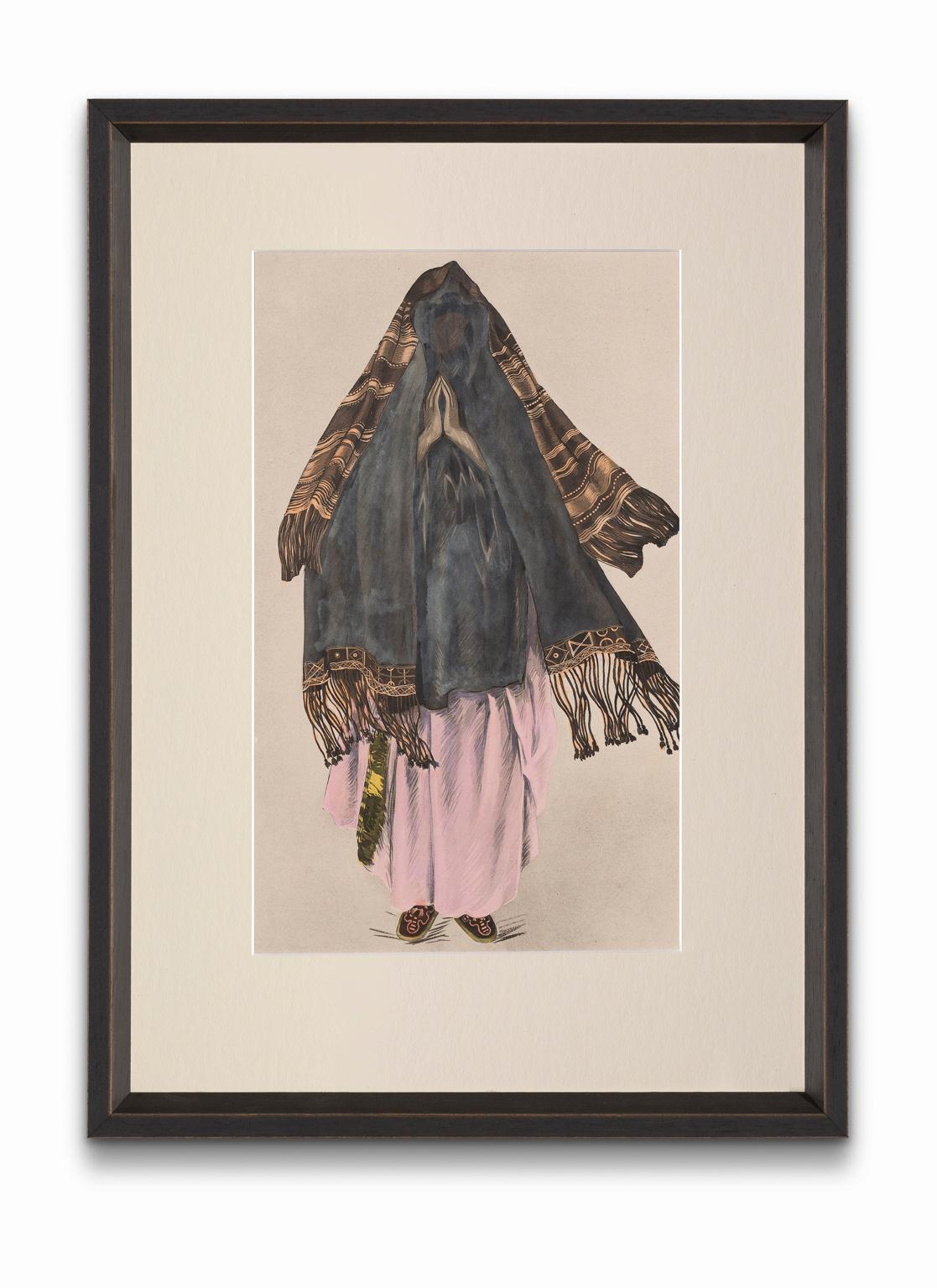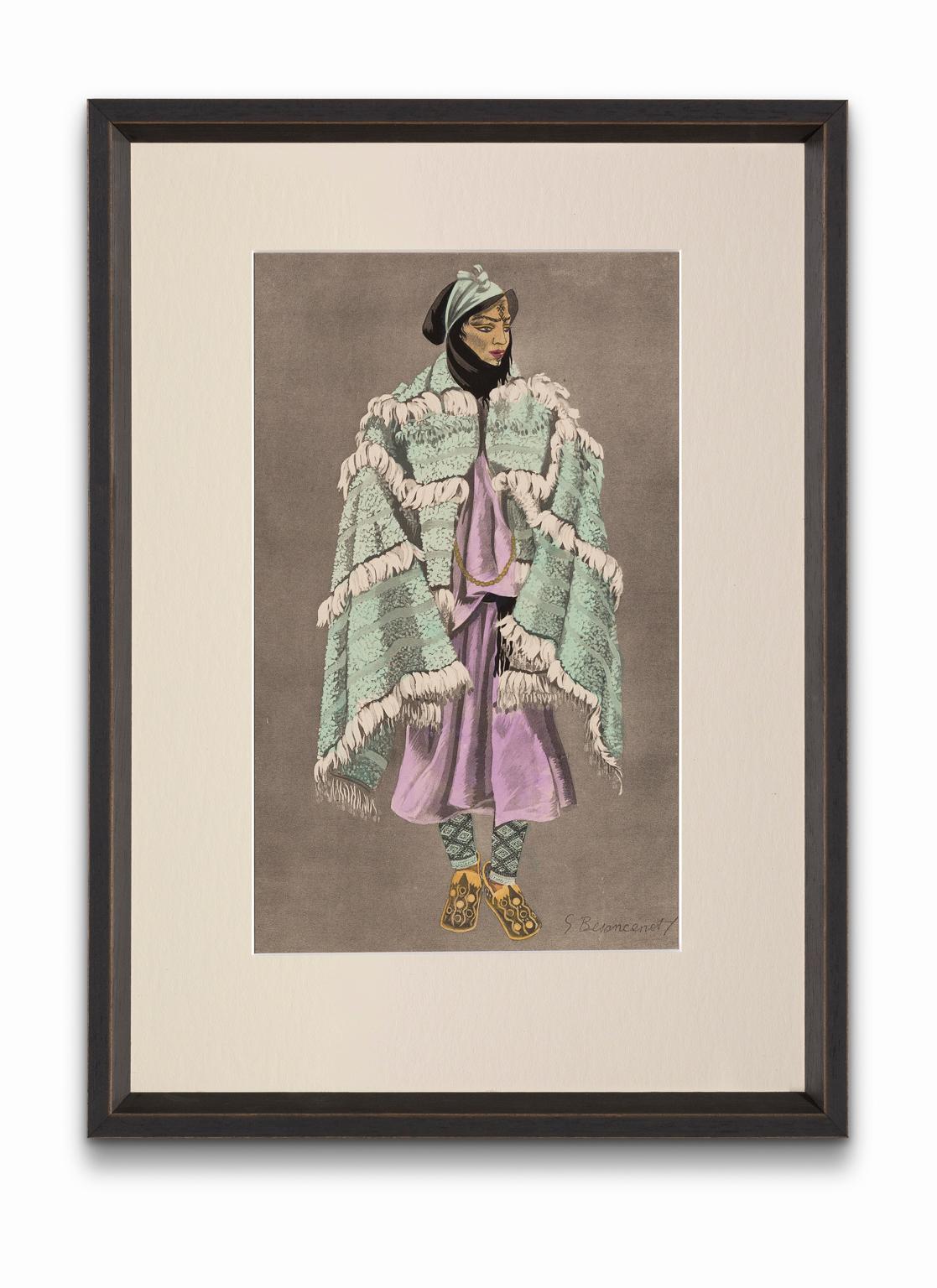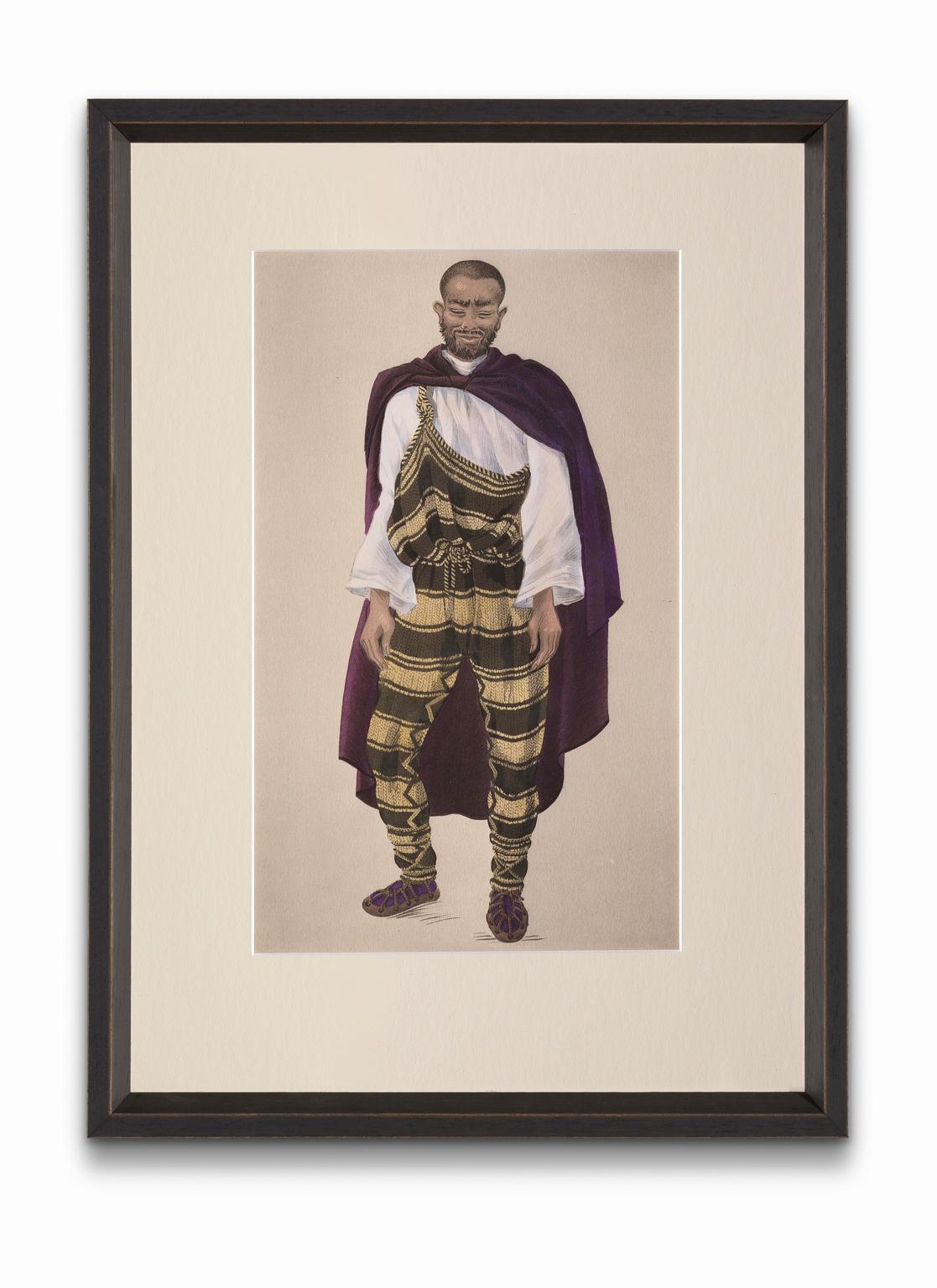Items Similar to "Formal Dress Called <Of The Maghzen>", from "Costumes of Morocco"
Want more images or videos?
Request additional images or videos from the seller
1 of 10
Jean Besancenot"Formal Dress Called <Of The Maghzen>", from "Costumes of Morocco"1942
1942
About the Item
"Costume du D'Apparat dit du Maghzen" translated to "Formal Dress Called " is plate number 14 in Jean Besancenot's stunning portraits and depictions of the people of Morocco from his series "Costumes du Maroc" ("Costumes of Morocco). The woman depicted here is dressed exquisitely and ornately in traditional formal clothing for the court of the sultan and his governing body, which was called the Makhzen but was rendered in French as Maghzen. Those who served in the court were called the moghzani, and they ruled where the sultanate did not delegate power to the tribal authorities.
Jean Besancenot's sixty plate reproduced and handcolored gouache on paper study on the diversity of Morocco's cultures is a work of stunning historical importance in tracing the rich and vibrant diversity of North Africa. Besancenot spent the 1930s traveling around Morocco, undertaking an awe-inspiring study of its peoples and rendered in vivid and precise detail the way they traditionally lived and dressed. Many of those outfits and cultural expressions are gone now, with Besancenot's watercolored drawings of them some of the only ways that people can now visit the past. The original manuscript of "Costumes du Maroc" is kept in the Royal Collection in Rabat, with only 310 copies of it produced. These prints are fresh from the folio and have been newly museum framed under conservator glass; unframed the image of the print is 12.75 x 7.75 inches. The tissue guards that bear the caption of the plate have been framed in the verso with the title visible behind clear plastic.
Jean Besancenot, real name Jean Girard, was a photographer, painter, designer, and ethnologist who was born in 1902 in Estrées-Saint-Denis. His work straddles the crossroads of art and ethnography as he was primarily interested in the costumes and ornaments of Morocco in the first half of the 20th century. He arrived for the first time in Morocco in 1934, a country he traveled through until 1939. There he produced a very rich ethnographic documentation on the traditional costumes and adornments of the different Moroccan ethnic groups. His work, composed of photographs, films, drawings and paintings, testifies to the aestheticism of Moroccan cultural heritage that was still marked by little Western influence.
His book "Costumes du Maroc" was published in 1942 at the end of his first trip and presents 60 documented plates of Moroccan costumes and their meanings in local customs. In 1947, Jean Besancenot became the iconographic manager of the Protectorate of France in Morocco where he was responsible for carrying out a documentation mission on Moroccan folklore and crafts. Besancenot encountered many difficulties in carrying out his work, some of the Moroccan Muslims being hostile to the representation of the human figure. As he was met with suspicion and superstition, with doors being frequently closed to all strangers and women rarely coming out with their faces uncovered, he had to work with photographic snapshots and wait a long time at the doors of homes and businesses to catch glimpses of the people. The work required five years of research and direct contact with the population. Besancenot chose 60 outfits that best characterize, according to him, the folklore of the Moroccan populations.
He subsequently became a collaborator at the Musée de l'Homme in Paris. His work was particularly honored at the Maison de la photographie de Marrakech in 2018. He died in 1992 in Bry-sur-Marne.
Photography by PD Rearick
- Creator:Jean Besancenot (1902 - 1992, French)
- Creation Year:1942
- Dimensions:Height: 19.75 in (50.17 cm)Width: 13.75 in (34.93 cm)
- Medium:
- Period:
- Condition:
- Gallery Location:Detroit, MI
- Reference Number:1stDibs: LU128618754242
About the Seller
5.0
Vetted Seller
These experienced sellers undergo a comprehensive evaluation by our team of in-house experts.
Established in 2014
1stDibs seller since 2019
96 sales on 1stDibs
Typical response time: 4 hours
- ShippingRetrieving quote...Ships From: Detroit, MI
- Return PolicyA return for this item may be initiated within 14 days of delivery.
More From This SellerView All
- "Woman of Tiznit Wearing the Amendil", from "Costumes of Morocco"Located in Detroit, MI"Femme de Tiznit Portant L'Amendil" translated to "Woman of Tiznit Wearing the Amendil" is plate number 47 in Jean Besancenot's stunning portraits and ...Category
1940s Portrait Prints
MaterialsGouache, Paper
- "Jewish Woman of the Tafilelt" from "Costumes of Morocco", Gouache on PaperLocated in Detroit, MI"Juive du Tafilelt" translated to "Jewish Woman of the Tafilelt" is plate number 55 in Jean Besancenot's stunning portraits and depictions of the peopl...Category
1940s Portrait Prints
MaterialsPaper, Gouache
- "Jewish Bride of Fez" from "Costumes of Morocco", Gouache on PaperLocated in Detroit, MI"Mariée Juive de Fès" translated to "Jewish Bride of Fez" is plate number 52 in Jean Besancenot's stunning portraits and depictions of the people of Morocco from his series "Costumes du Maroc" ("Costumes of Morocco). The woman depicted here is a young Jewish woman dressed for her wedding. She is dressed in traditional fashion for a Jewish wedding for the community in Morocco, a community with a long history in the region, especially the city of Fez, the second largest city in Morocco and known as the "Mecca of the West" for its contributions to religion and learning. For this reason and its northern proximity, Fez was a prominent destination for Jews fleeing Spain. Jewish history in Morocco is long, dating back to the 1st century, their numbers later increased by the Sephardic Jews who were expelled from Spain in 1492 by the Alhambra Decree. Jean Besancenot's sixty plate reproduced and handcolored gouache on paper study on the diversity of Morocco's cultures is a work of stunning historical importance in tracing the rich and vibrant diversity of North Africa. Besancenot spent the 1930s traveling around Morocco, undertaking an awe-inspiring study of its peoples and rendered in vivid and precise detail the way they traditionally lived and dressed. Many of those outfits and cultural expressions are gone now, with Besancenot's watercolored drawings of them some of the only ways that people can now visit the past. The original manuscript of "Costumes du Maroc" is kept in the Royal Collection in Rabat, with only 310 copies of it produced. These prints are fresh from the folio and have been newly museum framed under conservator glass; unframed the image of the print is 12.75 x 7.75 inches. The tissue guards that bear the caption of the plate have been framed in the verso with the title visible behind clear plastic. Jean Besancenot, real name Jean Girard, was a photographer, painter, designer, and ethnologist who was born in 1902 in Estrées-Saint-Denis. His work straddles the crossroads of art and ethnography as he was primarily interested in the costumes and ornaments of Morocco in the first half of the 20th century. He arrived for the first time in Morocco in 1934, a country he traveled through until 1939. There he produced a very rich ethnographic documentation on the traditional costumes and adornments of the different Moroccan ethnic groups. His work, composed of photographs, films, drawings and paintings, testifies to the aestheticism of Moroccan cultural heritage that was still marked by little Western influence. His book "Costumes du Maroc" was published in 1942 at the end of his first trip and presents 60 documented plates of Moroccan costumes...Category
1940s Portrait Prints
MaterialsGouache, Paper
- "Woman Of Tagmout (Singing the Ahwash)" from "Costumes of Morocco"Located in Detroit, MI"Femme de Tagmout Chantant L'Ahwas" translated to "Woman Of Tagmout (Singing the Ahwash)" is plate number 44 in Jean Besancenot's stunning portraits and depictions of the people of Morocco from his series "Costumes du Maroc" ("Costumes of Morocco). The woman depicted here is veiled and draped and in the midst of singing the "ahwash", a traditional song and dance from the regions of southern Morocco, such as Tagmout, and which has some roots in the pre-Islamic cultures of the Amazigh (also known as the Berbers) and is performed primarily by the Shilha, a sub-group of the Berbers. The ahwash is a community performance that incorporates song, dance, poetry, and frame drums...Category
1940s Portrait Prints
MaterialsGouache, Paper
- "Woman of the Aït MGuild" from "Costumes of Morocco", Gouache on PaperLocated in Detroit, MI"Femme Des Aït MGuild" translated to "Woman of the Aït MGuild" is plate number 19 in Jean Besancenot's stunning portraits and depictions of the people ...Category
1940s Portrait Prints
MaterialsGouache, Paper
- "Man of The Ouanergui Carrying the Tabbane" from "Costumes of Morocco"Located in Detroit, MI"Homme de L'Ouanergui Portant le Tabban" translated to "Man of The Ouanergui Carrying the Tabbane" is plate number 25 in Jean Besancenot's stunning por...Category
1940s Portrait Prints
MaterialsPaper, Gouache
You May Also Like
- View from below - Contemporary Gouache Painting, AbstractionBy Jacek SowickiLocated in Warsaw, PLJACEK SOWICKI (born in 1948) He studied at the Academy of Fine Arts in Cracow and graduated from the Academy Of Fine Arts in Warsaw in 1973. In 1984-89 he run the graphics atelier at...Category
Early 2000s Abstract Figurative Prints
MaterialsGouache, Cardboard
- J.E. HatBy Kim FrohsinLocated in Burlingame, CAWoman with red hair in a hat with feather, in green, black and white, Monotype ev edition 5/6 with hand coloring and mixed media work. Kim Frohsin spent 12 years working on monotype ...Category
1990s Contemporary Portrait Prints
MaterialsMixed Media, Gouache, Monotype
- Neapolitan Fishermen - Original Gouache - 19th CenturyLocated in Roma, ITNeapolitan Fishermen is an original modern artwork realized by Anonymous Artist of thr XIX Century. Original gouache. Hand-signed on the lower center corner: "LeDoux". The work is...Category
19th Century Modern Figurative Prints
MaterialsGouache
- Portrait of Giuseppe Garibaldi in front of the Sea - Gouache - 19th CenturyLocated in Roma, IT"Portrait of Giuseppe Garibaldi in front of the Sea" is an original mixed media (pencil, white lead) and gouache drawing on ivory-colorated cardboard by Anonymous Artist of XIX Century, perhaps Alessandro Sani...Category
19th Century Modern Figurative Prints
MaterialsGouache
- A Chinese Watchman, from The Costume of China, by G.H. Mason, engr. John DadleyLocated in Middletown, NYLondon: 1799. Copperplate stipple engraving with hand coloring in watercolor, 17 1/2 x 10 1/4 inches (445 x 260 mm) (sheet), full margins. In very good condition with some minor, lig...Category
Late 18th Century Old Masters Figurative Prints
MaterialsWatercolor, Handmade Paper, Engraving
- Hand-coloured Print of weeping mythical sculpture angels in Walnut FrameLocated in London, GBHand-coloured tableau of a weeping spirit and her guardians, immobilised in marble. A disjointed narrative looking at recovery and protection, the angels shield the spirit with tender embraces and cry for her when alone. Taken from The Sialia Marbles, a series of portraits containing ephemeral human sculptures taken between 2016-19. Together these works act as tales contained in a fictional sculpture hall, in direct reaction to Andre Malraux’s 1947 Le Musee Imaginaire (Museum Without Walls). During the beginning of the 'Museum Age' in the 18th century , writer Johann Wolfgang Von Goethe discussed mythical...Category
18th Century Victorian Nude Photography
MaterialsCotton, Archival Pigment, Pigment, Color, Walnut, Paint, Photographic Fi...
Recently Viewed
View AllMore Ways To Browse
Used Formal Dresses
Ethnic Dress
Vintage Dresses From 1940
Vintage Country Dress
Vintage Country Dresses
Moroccan Plate
Moroccan Plater
Moroccan Drawing
Morocco Drawing
French Dress 1930s
Long Formal Dress
Formal Vintage Outfit
1930s Printed Dress
African Gouache
Moroccan Woman
Original Vintage 1930s Dress Dresses
Real Vintage Dress
La France Vintage Clothing
